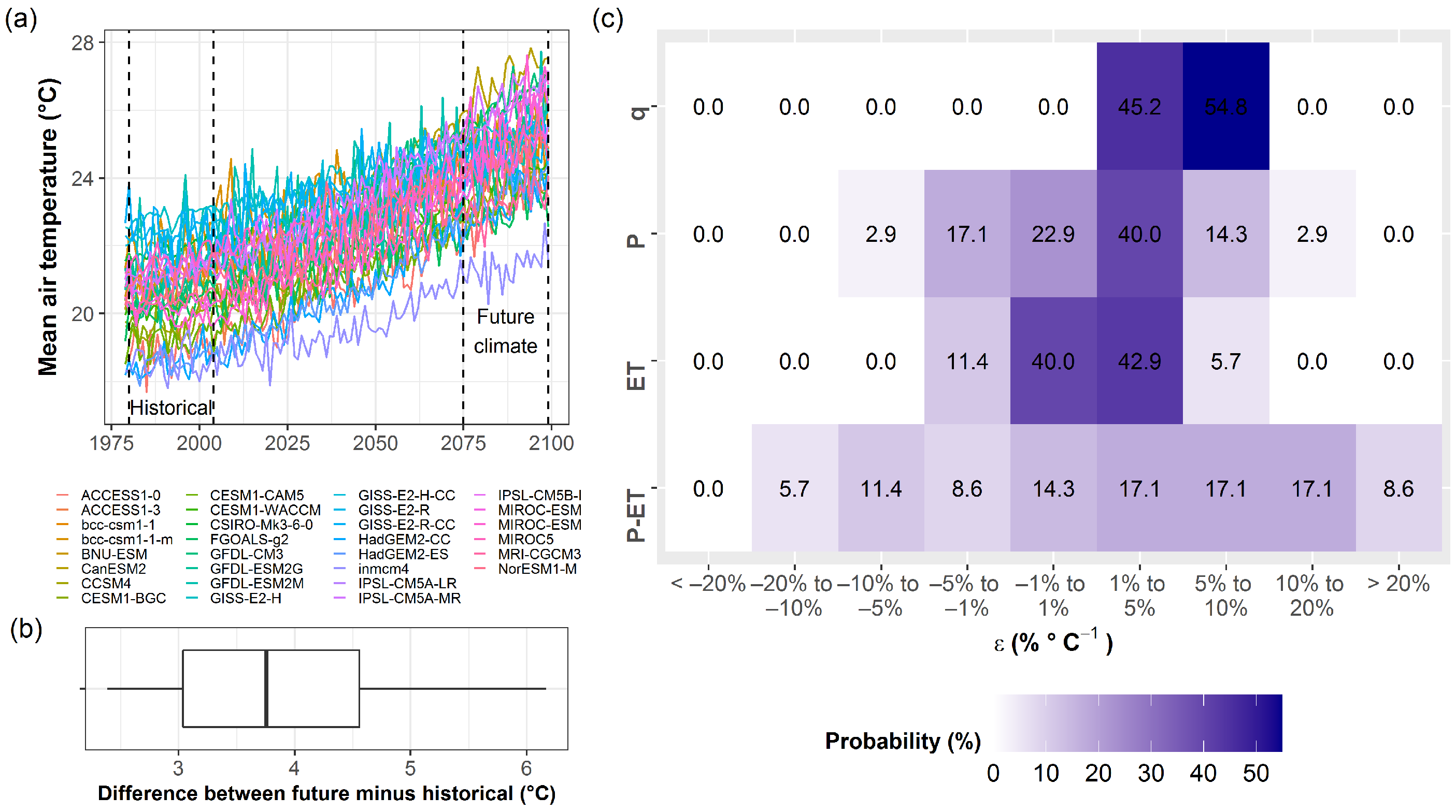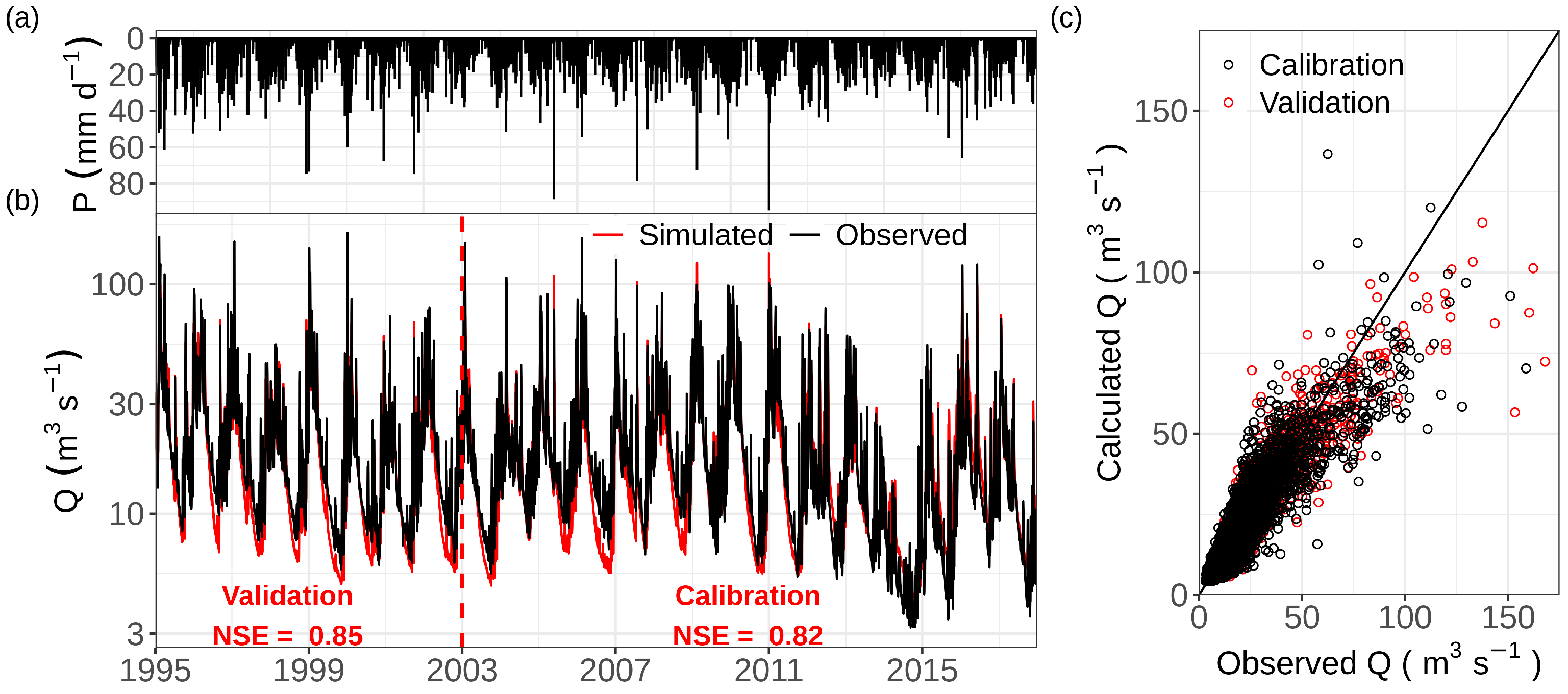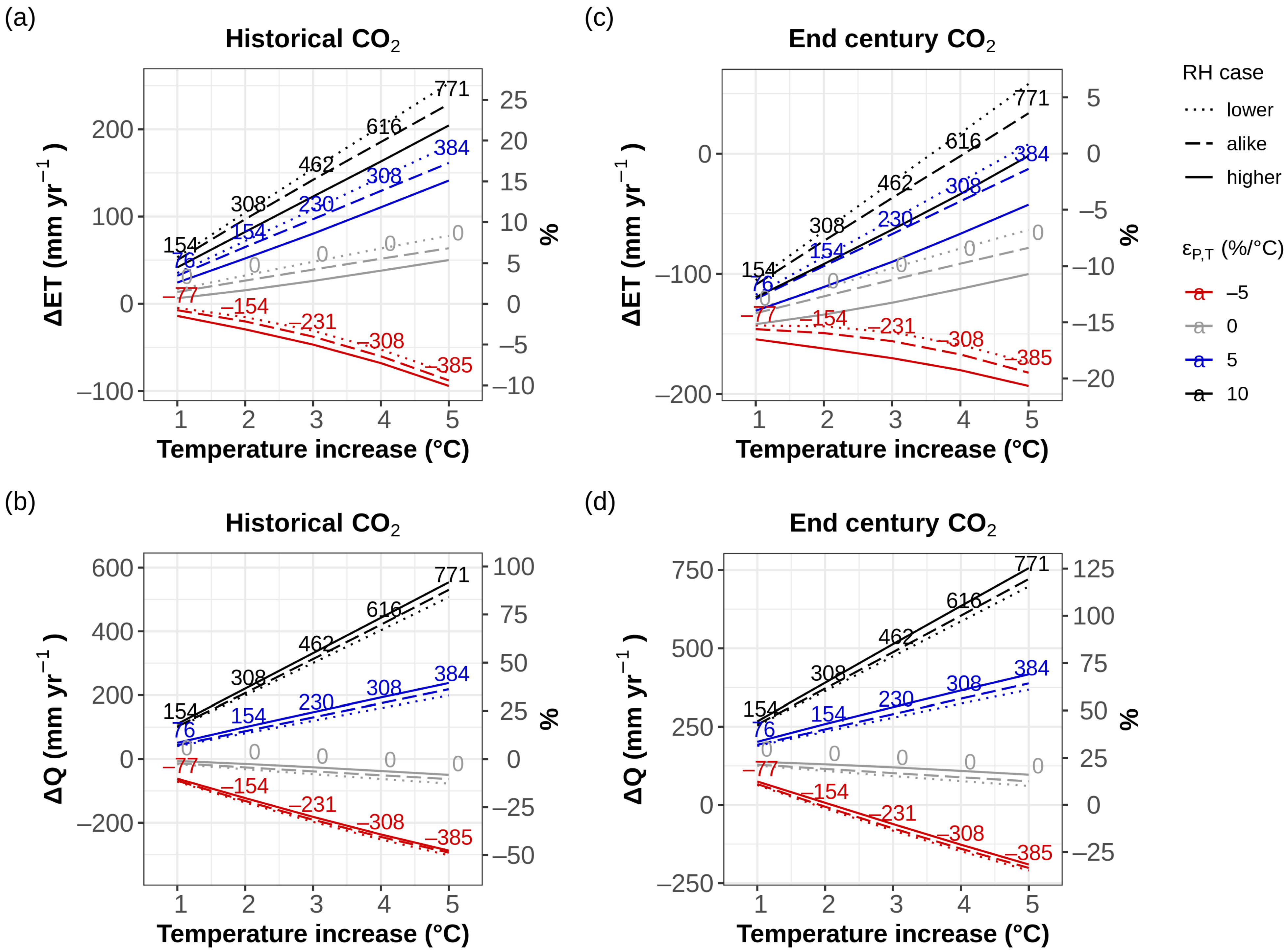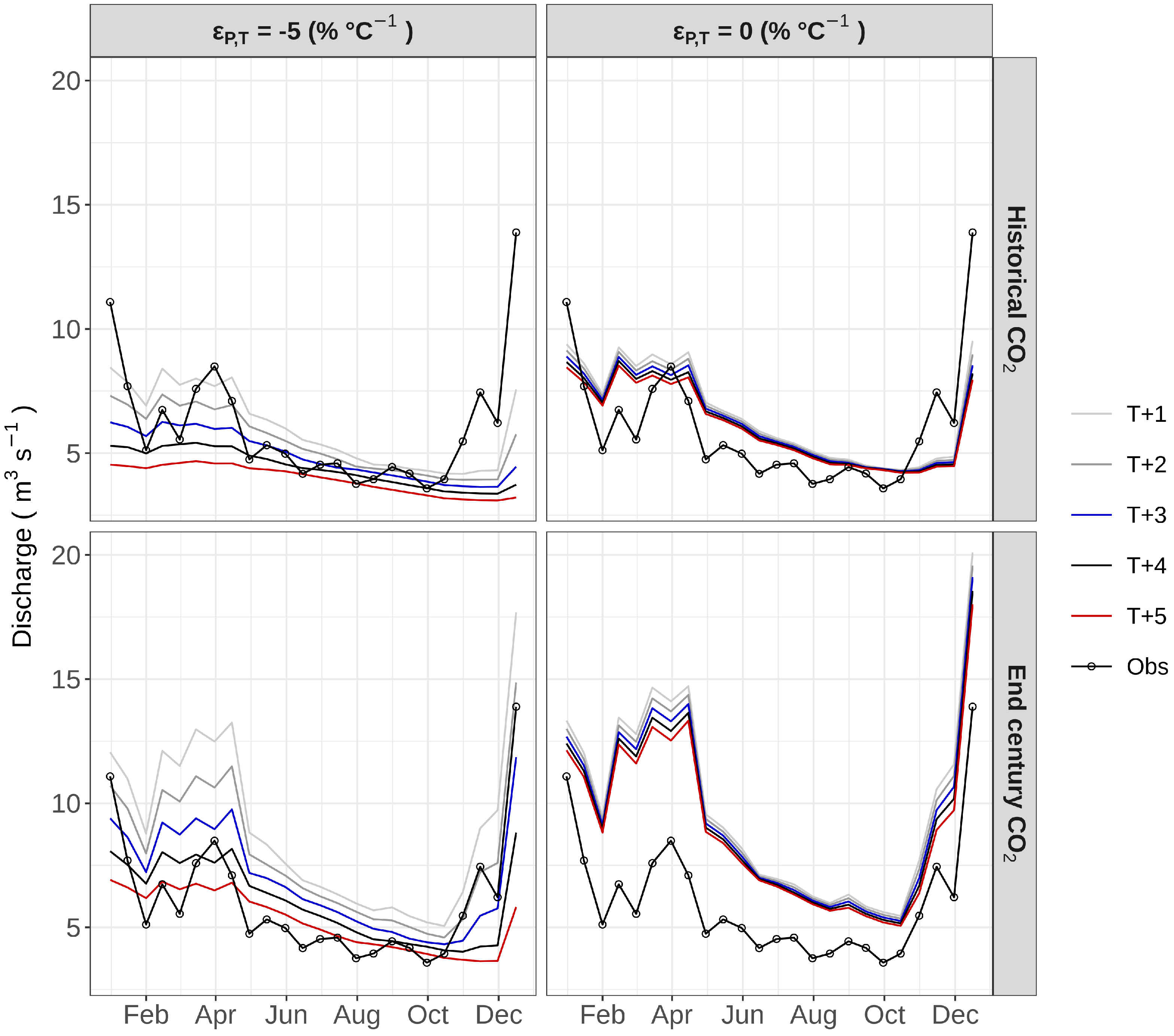Hydrologic Impact of Climate Change in the Jaguari River in the Cantareira Reservoir System
Abstract
:1. Introduction
2. Materials and Methods
2.1. Study Area
2.2. SWAT Model Description and Setup
2.3. Calibration
2.4. Experimental Design of Perturbations in Climatic Forcings
The Set of Experiments
3. Results and Discussion
3.1. Model Calibration
3.2. Climate Change Impacts on ET and Q
3.3. Comparison of Hydrological Simulations to Observations and Global Models
4. Conclusions
Author Contributions
Funding
Institutional Review Board Statement
Informed Consent Statement
Data Availability Statement
Acknowledgments
Conflicts of Interest
Appendix A. Adjustments in Evapotranspiration
| Unit | Forest | Pasture | |
|---|---|---|---|
| BLAI Maximum potential leaf area index | 5.2 | 2.5 | |
| ALAI_MIN Minimum leaf area index for plant during dormant period | 4.5 | 1.0 | |
| GSI Maximum stomatal conductance | mm | 8.5 | 1.0 |
| ESCO Soil evaporation compensation factor | - | 1.0 | 1.0 |
| RDMX Maximum root depth | m | 2.0 | 2.0 |
| VPDFR vpd corresponding to the second point on the stomatal curve | kPa | 2.0 | 2.0 |

Appendix B. Adjustments in the Drought Flow
| Parameter | Unit | Value |
|---|---|---|
| Bulk density | 0.9 | |
| Saturated hydraulic conductivity | 65 | |
| Available water content | - | 0.13 |
Appendix C. Calibration Outputs
| Parameter | Definition | Range | Default | Best |
|---|---|---|---|---|
| r CN2 | Curve number at condition II | −40%, 40% | 0% | −39.7 |
| v LAT_TTIME | Lateral flow travel time (days) | 1.0, 6.0 | 0.0 | 4.0 |
| v OV_N | Manning’s “n” value for overland flow | 0.17, 0.4 | 0.1 | 0.36 |
| r HRU_SLP | Average slope of the subbasin (m ) | −25%, 25% | 0% | −15% |
| v CH_S1 | Average slope of tributary channels (m ) | 0.001, 0.055 | * | 0.010 |
| r SLSUBBSN | Average slope length (m) | −25%, 25% | 0% | −2.6% |
| v CH_S2 | Average slope of main channel along the channel length (m ) | 0.001, 0.002 | * | 0.013 |
| v CH_N2 | Manning’s “n” value for the main channel | 0.025, 0.3 | 0.014 | 0.14 |
| v CH_K2 | Effective hydraulic conductivity in the main channel alluvium (mm ) | 5, 120 | 0 | 36 |
| v RCHRG_DP | Deep aquifer percolation factor | 0.00, 0.2 | 0.05 | 0.19 |
| v ALPHA_BF | Baseflow recession constant (days) | 0.0, 0.1 | 0.048 | 0.027 |
| a REVAPMN | Threshold depth of water in the shallow aquifer to revap or percolation do deep aquifer occur (mm) | −500, 0 | 750 | −177 |
| r GW_DELAY | Groundwater delay (days) | −20%, 20% | 31 | 1.8% |
| v GW_REVAP | Groundwater “revap” coefficient | 0.1, 0.5 | 0.02 | 0.2 |
| a GWQMN | Threshold depth of water in the shallow aquifer required for base flow to occur (mm) | −100, 100 | 400 | 98 |
References
- Coelho, C.A.S.; de Oliveira, C.P.; Ambrizzi, T.; Reboita, M.S.; Carpenedo, C.B.; Campos, J.L.P.S.; Tomaziello, A.C.N.; Pampuch, L.A.; Custódio, M.d.S.; Dutra, L.M.M.; et al. The 2014 southeast Brazil austral summer drought: Regional scale mechanisms and teleconnections. Clim. Dyn. 2016, 46, 3737–3752. [Google Scholar] [CrossRef]
- Nobre, C.A.; Marengo, J.A.; Seluchi, M.E.; Cuartas, L.A.; Alves, L.M. Some Characteristics and Impacts of the Drought and Water Crisis in Southeastern Brazil during 2014 and 2015. J. Water Resour. Prot. 2016, 8, 252–262. [Google Scholar] [CrossRef] [Green Version]
- Milano, M.; Reynard, E.; Muniz-Miranda, G.; Guerrin, J. Water Supply Basins of São Paulo Metropolitan Region: Hydro-Climatic Characteristics of the 2013–2015 Water Crisis. Water 2018, 10, 1517. [Google Scholar] [CrossRef] [Green Version]
- Millington, N. Producing water scarcity in São Paulo, Brazil: The 2014–2015 water crisis and the binding politics of infrastructure. Polit. Geogr. 2018, 65, 26–34. [Google Scholar] [CrossRef]
- Escobar, H. Drought triggers alarms in Brazil’s biggest metropolis. Science 2015, 347, 812. [Google Scholar] [CrossRef]
- Otto, F.E.L.; Haustein, K.; Uhe, P.; Coelho, C.A.S.; Aravequia, J.A.; Almeida, W.; King, A.; Coughlan de Perez, E.; Wada, Y.; van Oldenborgh, G.; et al. Factors Other Than Climate Change, Main Drivers of 2014/15 Water Shortage in Southeast Brazil. Bull. Am. Meteorol. Soc. 2016, 96, S35–S40. [Google Scholar] [CrossRef]
- IPCC. Summary for Policymakers. In Climate Change 2021: The Physical Science Basis. Contribution of Working Group I to the Sixth Assessment Report of the Intergovernmental Panel on Climate Change; Masson-Delmotte, V., Zhai, P., Pirani, A., Connors, S., Péan, C., Berger, S., Caud, N., Chen, Y., Goldfarb, L., Gomis, M., et al., Eds.; Cambridge University Press: Cambridge, MA, USA, 2021; in press. [Google Scholar]
- He, C.; Liu, Z.; Wu, J.; Pan, X.; Fang, Z.; Li, J.; Bryan, B.A. Future global urban water scarcity and potential solutions. Nat. Commun. 2021, 12, 4667. [Google Scholar] [CrossRef]
- Leavesley, G. Modeling the effects of climate change on water resources—A review. Clim. Chang. 1994, 28, 159–177. [Google Scholar] [CrossRef]
- Teng, J.; Chiew, F.H.S.; Vaze, J.; Marvanek, S.; Kirono, D.G.C. Estimation of Climate Change Impact on Mean Annual Runoff across Continental Australia Using Budyko and Fu Equations and Hydrological Models. J. Hydrometeorol. 2012, 13, 1094–1106. [Google Scholar] [CrossRef]
- Creed, I.F.; Spargo, A.T.; Jones, J.A.; Buttle, J.M.; Adams, M.B.; Beall, F.D.; Booth, E.G.; Campbell, J.L.; Clow, D.; Elder, K.; et al. Changing forest water yields in response to climate warming: Results from long-term experimental watershed sites across North America. Glob. Chang. Biol. 2014, 20, 3191–3208. [Google Scholar] [CrossRef] [Green Version]
- Held, I.M.; Soden, B.J. Robust Responses of the Hydrological Cycle to Global Warming. J. Clim. 2006, 19, 5686–5699. [Google Scholar] [CrossRef]
- Byrne, M.P.; O’Gorman, P.A. Understanding Decreases in Land Relative Humidity with Global Warming: Conceptual Model and GCM Simulations. J. Clim. 2016, 29, 9045–9061. [Google Scholar] [CrossRef]
- Guo, D.; Westra, S.; Maier, H.R. Sensitivity of potential evapotranspiration to changes in climate variables for different Australian climatic zones. Hydrol. Earth Syst. Sci. 2017, 21, 2107–2126. [Google Scholar] [CrossRef] [Green Version]
- Ainsworth, E.A.; Rogers, A. The response of photosynthesis and stomatal conductance to rising [CO2]: Mechanisms and environmental interactions. Plant Cell Environ. 2007, 30, 258–270. [Google Scholar] [CrossRef]
- Purcell, C.; Batke, S.P.; Yiotis, C.; Caballero, R.; Soh, W.K.; Murray, M.; Mcelwain, J.C. Increasing stomatal conductance in response to rising atmospheric CO2. Ann. Bot. 2018, 121, 1137–1149. [Google Scholar] [CrossRef] [Green Version]
- Milly, P.; Dunne, K. Potential evapotranspiration and continental drying. Nat. Clim. Chang. 2016, 6, 946–949. [Google Scholar] [CrossRef]
- Habermann, E.; Martin, J.A.B.S.; Contin, D.R.; Bossan, V.P.; Barboza, A.; Braga, M.R.B.; Groppo, M.; Martinez, C.A. Increasing atmospheric CO2 and canopy temperature induces anatomical and physiological changes in leaves of the C4 forage species Panicum maximum. PLoS ONE 2019, 14, e0212506. [Google Scholar] [CrossRef] [Green Version]
- Betts, R.A.; Boucher, O.; Collins, M.; Cox, P.M.; Falloon, P.D.; Gedney, N.; Hemming, D.L.; Huntingford, C.; Jones, C.D.; Sexton, D.M.H.; et al. Projected increase in continental runoff due to plant responses to increasing carbon dioxide. Nature 2007, 448, 1037–1041. [Google Scholar] [CrossRef]
- Prudhomme, C.; Giuntoli, I.; Robinson, E.L.; Clark, D.B.; Arnell, N.W.; Dankers, R.; Fekete, B.M.; Franssen, W.; Gerten, D.; Gosling, S.N.; et al. Hydrological droughts in the 21st century, hotspots and uncertainties from a global multimodel ensemble experiment. Proc. Natl. Acad. Sci. USA 2014, 111, 3262–3267. [Google Scholar] [CrossRef] [Green Version]
- Di Baldassarre, G.; Elshamy, M.; van Griensven, A.; Soliman, E.; Kigobe, M.; Ndomba, P.; Mutemi, J.; Mutua, F.; Moges, S.; Xuan, Y.; et al. Future hydrology and climate in the River Nile basin: A review. Hydrol. Sci. J. 2011, 56, 199–211. [Google Scholar] [CrossRef] [Green Version]
- Fowler, H.J.; Blenkinsop, S.; Tebaldi, C. Linking climate change modelling to impacts studies: Recent advances in downscaling techniques for hydrological modelling. Int. J. Climatol. 2007, 27, 1547–1578. [Google Scholar] [CrossRef]
- Xu, C. Climate Change and Hydrologic Models: A Review of Existing Gaps and Recent Research Developments. Water Resour. Manag. 1999, 13, 369–392. [Google Scholar] [CrossRef]
- Wilby, R.L.; Harris, I. A framework for assessing uncertainties in climate change impacts: Low-flow scenarios for the River Thames, UK. Water Resour. Res. 2006, 42, 2. [Google Scholar] [CrossRef]
- Döll, P.; Trautmann, T.; Gerten, D.; Schmied, H.M.; Ostberg, S.; Saaed, F.; Schleussner, C.F. Risks for the global freshwater system at 1.5 °C and 2 °C global warming. Environ. Res. Lett. 2018, 13, 044038. [Google Scholar] [CrossRef]
- Nakicenovic, N.; Alcamo, J.; Grubler, A.; Riahi, K.; Roehrl, R.; Rogner, H.H.; Victor, N. Special Report on Emissions Scenarios (SRES), A Special Report of Working Group III of the Intergovernmental Panel on Climate Change; Cambridge University Press: Cambridge, MA, USA, 2000. [Google Scholar]
- van Vuuren, D.P.; Edmonds, J.; Kainuma, M.; Riahi, K.; Thomson, A.; Hibbard, K.; Hurtt, G.C.; Kram, T.; Krey, V.; Lamarque, J.F.; et al. The representative concentration pathways: An overview. Clim. Chang. 2011, 109, 5–31. [Google Scholar] [CrossRef]
- Riahi, K.; van Vuuren, D.P.; Kriegler, E.; Edmonds, J.; O’Neill, B.C.; Fujimori, S.; Bauer, N.; Calvin, K.; Dellink, R.; Fricko, O.; et al. The Shared Socioeconomic Pathways and their energy, land use, and greenhouse gas emissions implications: An overview. Glob. Environ. Chang. 2017, 42, 153–168. [Google Scholar] [CrossRef] [Green Version]
- Arnell, N.W. Uncertainty in the relationship between climate forcing and hydrological response in UK catchments. Hydrol. Earth Syst. Sci. 2011, 15, 897–912. [Google Scholar] [CrossRef] [Green Version]
- Xu, H.; Taylor, R.G.; Xu, Y. Quantifying uncertainty in the impacts of climate change on river discharge in sub-catchments of the Yangtze and Yellow River Basins, China. Hydrol. Earth Syst. Sci. 2011, 15, 333–344. [Google Scholar] [CrossRef] [Green Version]
- Magrin, G.O.; Marengo, J.A.; Boulanger, J.P.; Buckeridge, M.S.; Castellanos, E.; Poveda, G.; Scarano, V. Central and South America. In Climate Change 2014: Impacts, Adaptation, and Vulnerability. Part B: Regional Aspects. Contribution of Working Group II to the Fifth Assessment Report of the Intergovernmental Panel on Climate Change; Barros, V., Field, C., Dokken, D., Mastrandrea, M., Mach, K., Bilir, T., Chatterjee, M., Ebi, K., Estrada, Y., Genova, R., et al., Eds.; Cambridge University Press: Cambridge, UK; New York, NY, USA, 2014; pp. 1499–1566. [Google Scholar]
- Kelman, J. Water Supply to the Two Largest Brazilian Metropolitan Regions. Aquat. Procedia 2015, 5, 13–21. [Google Scholar] [CrossRef]
- Gassman, P.W.; Reyes, M.R.; Green, C.H.; Arnold, J.G. The Soil and Water Assessment Tool: Historical development, applications, and future research directions. Trans. ASAE 2007, 50, 1211–1250. [Google Scholar] [CrossRef] [Green Version]
- Neitsch, S.; Arnold, J.; Kiniry, J.; Williams, J. Soil & Water Assessment Tool Theoretical Documentation Version 2009. Tex. Water Resour. Inst. 2011, 543, 591–600. [Google Scholar] [CrossRef]
- Alaska Satellite Facility Distributed Active Archive Center—ASF DAAC. ALOS PALSAR Radiometric Terrain Corrected Low Res. 2015. Available online: https://asf.alaska.edu/data-sets/derived-data-sets/alos-palsar-rtc/alos-palsar-radiometric-terrain-correction/ (accessed on 30 April 2018).
- Brazilian Institute of Geography and Statistics—IBGE. Vector File of Brazilian Land Cover and Land Use for 2012; IBGE: Rio de Janeiro, Brazil, 2015.
- Federal University of Viçosa—UFV ; Minas Gerais Technological Center Foundation—CETEC; Federal University of Lavras—UFLA; State Environment Foundation—FEAM. Soil Map from Minas Gerais State. 2010. Available online: http://www.feam.br/noticias/1/949-mapas-de-solo-do-estado-de-minas-gerais (accessed on 15 April 2018).
- Dee, D.P.; Uppala, S.M.; Simmons, A.J.; Berrisford, P.; Poli, P.; Kobayashi, S.; Andrae, U.; Balmaseda, M.A.; Balsamo, G.; Bauer, P.; et al. The ERA-Interim reanalysis: Configuration and performance of the data assimilation system. Q. J. R. Meteorol. Soc. 2011, 137, 553–597. [Google Scholar] [CrossRef]
- Pebesma, E.J. Multivariable geostatistics in S: The gstat package. Comput. Geosci. 2004, 30, 683–691. [Google Scholar] [CrossRef]
- Souza, C.M.; Shimbo, J.; Rosa, M.R.; Parente, L.L.; Alencar, A.; Rudorff, B.F.T.; Hasenack, H.; Matsumoto, M.; Ferreira, L.; Souza-Filho, P.W.M.; et al. Reconstructing Three Decades of Land Use and Land Cover Changes in Brazilian Biomes with Landsat Archive and Earth Engine. Remote Sens. 2020, 12, 2735. [Google Scholar] [CrossRef]
- Pontes, L.M.; Viola, M.R.; Silva, M.L.N.; Bispo, D.F.A.; Curi, N. Hydrological modeling of tributaries of Cantareira System, Southeast Brazil, with the SWAT model. Eng. Agríc. 2016, 4430, 1037–1049. [Google Scholar] [CrossRef] [Green Version]
- Thoning, K.; Crotwell, A.; Mund, J. Atmospheric Carbon Dioxide Dry Air Mole Fractions from continuous measurements at Mauna Loa, Hawaii, Barrow, Alaska, American Samoa and South Pole. 1973–2019; National Oceanic and Atmospheric Administration (NOAA); Global Monitoring Laboratory (GML): Boulder, CO, USA, 2020. [CrossRef]
- Basic Sanitation Company of the State of São Paulo—SABESP. Historical Time Series of Rainfall and Streamflow Data. 2018. Available online: https://mananciais.sabesp.com.br/HistoricoSistemas (accessed on 1 June 2018).
- Strauch, M.; Bernhofer, C.; Koide, S.; Volk, M.; Lorz, C.; Makeschin, F. Using precipitation data ensemble for uncertainty analysis in SWAT streamflow simulation. J. Hydrol. 2012, 414–415, 413–424. [Google Scholar] [CrossRef]
- Mota da Silva, J. The Hydrological Environment Service from Permanent Preservation Areas: A Case Study with Small and Mesoscale Numerical Modeling from Piracicaba River Watershed. Ph.D. Thesis, University of São Paulo, São Paulo, Brazil, 2013. [Google Scholar]
- Rafee, S.A.A.; Uvo, C.B.; Martins, J.A.; Domingues, L.M.; Rudke, A.P.; Fujita, T.; Freitas, E.D. Large-Scale Hydrological Modelling of the Upper Paraná River Basin. Water 2019, 11, 882. [Google Scholar] [CrossRef] [Green Version]
- Abbaspour, K.C. SWAT-CUP: SWAT Calibration and Uncertainty Programs—A User Manual. 2015. Available online: https://swat.tamu.edu/media/114860/usermanual_swatcup.pdf (accessed on 1 June 2017).
- Schürz, C. SWATplusR: Running SWAT2012 and SWAT+ Projects in R. R Package Version 0.2.7. 2019. Available online: https://zenodo.org/record/3373859#.YleLuLYzaUk (accessed on 1 June 2017).
- R Core Team. R: A Language and Environment for Statistical Computing; R Foundation for Statistical Computing: Vienna, Austria, 2013. [Google Scholar]
- Taylor, K.E.; Stouffer, R.J.; Meehl, G.A. An Overview of CMIP5 and the Experiment Design. Bull. Am. Meteorol. Soc. 2012, 93, 485–498. [Google Scholar] [CrossRef] [Green Version]
- Miralles, D.G.; Holmes, T.R.H.; De Jeu, R.A.M.; Gash, J.H.; Meesters, A.G.C.A.; Dolman, A.J. Global land-surface evaporation estimated from satellite-based observations. Hydrol. Earth Syst. Sci. 2011, 15, 453–469. [Google Scholar] [CrossRef] [Green Version]
- Mu, Q.; Zhao, M.; Running, S.W. Improvements to a MODIS global terrestrial evapotranspiration algorithm. Remote Sens. Environ. 2011, 115, 1781–1800. [Google Scholar] [CrossRef]
- Dirmeyer, P.A.; Gao, X.; Zhao, M.; Guo, Z.; Oki, T.; Hanasaki, N. GSWP-2: Multimodel Analysis and Implications for Our Perception of the Land Surface. Bull. Am. Meteorol. Soc. 2006, 87, 1381–1397. [Google Scholar] [CrossRef] [Green Version]
- Zhang, K.; Kimball, J.S.; Nemani, R.R.; Running, S.W. A continuous satellite-derived global record of land surface evapotranspiration from 1983 to 2006. Water Resour. Res. 2010, 46, 8800. [Google Scholar] [CrossRef] [Green Version]
- Liu, W.; Wang, L.; Zhou, J.; Li, Y.; Sun, F.; Fu, G.; Li, X.; Sang, Y.F. A worldwide evaluation of basin-scale evapotranspiration estimates against the water balance method. J. Hydrol. 2016, 538, 82–95. [Google Scholar] [CrossRef] [Green Version]
- da Rocha, H.R.; Manzi, A.O.; Cabral, O.M.; Miller, S.D.; Goulden, M.L.; Saleska, S.R.; Coupe, N.; Wofsy, S.C.; Borma, L.S.; Artaxo, P.; et al. Patterns of water and heat flux across a biome gradient from tropical forest to savanna in Brazil. J. Geophys. Res. 2009, 114, G00B12. [Google Scholar] [CrossRef]
- Save, H.; Bettadpur, S.; Tapley, B.D. High-resolution CSR GRACE RL05 Mascons. J. Geophys. Res. Solid Earth 2016, 121, 7547–7569. [Google Scholar] [CrossRef]
- Moriasi, D.N.; Gitau, M.W.; Pai, N.; Daggupati, P. Hydrologic and Water Quality Models: Performance Measures and Evaluation Criteria. Trans. ASABE 2015, 58, 1763–1785. [Google Scholar] [CrossRef] [Green Version]
- Krause, P.; Boyle, D.P.; Bäse, F. Comparison of different efficiency criteria for hydrological model assessment. Adv. Geosci. 2005, 5, 89–97. [Google Scholar] [CrossRef] [Green Version]
- Althoff, D.; Rodrigues, L.N. Goodness-of-fit criteria for hydrological models: Model calibration and performance assessment. J. Hydrol. 2021, 600, 126674. [Google Scholar] [CrossRef]
- Zheng, F.; Maier, H.R.; Wu, W.; Dandy, G.C.; Gupta, H.V.; Zhang, T. On Lack of Robustness in Hydrological Model Development Due to Absence of Guidelines for Selecting Calibration and Evaluation Data: Demonstration for Data-Driven Models. Water Resour. Res. 2018, 54, 1013–1030. [Google Scholar] [CrossRef]
- Nguyen, V.T.; Dietrich, J. Modification of the SWAT model to simulate regional groundwater flow using a multicell aquifer. Hydrol. Process. 2018, 32, 939–953. [Google Scholar] [CrossRef]
- Bonan, G. Ecological Climatology: Concepts and Applications, 3rd ed.; Cambridge University Press: Cambridge, MA, USA, 2015. [Google Scholar] [CrossRef]
- Leuzinger, S.; Körner, C. Water savings in mature deciduous forest trees under elevated CO2. Glob. Chang. Biol. 2007, 13, 2498–2508. [Google Scholar] [CrossRef]
- Morgan, J.A.; LeCain, D.R.; Pendall, E.; Blumenthal, D.M.; Kimball, B.A.; Carrillo, Y.; Williams, D.G.; Heisler-White, J.; Dijkstra, F.A.; West, M. C4 grasses prosper as carbon dioxide eliminates desiccation in warmed semi-arid grassland. Nature 2011, 476, 202–205. [Google Scholar] [CrossRef]
- Berg, A.; Sheffield, J. Evapotranspiration Partitioning in CMIP5 Models: Uncertainties and Future Projections. J. Clim. 2019, 32, 2653–2671. [Google Scholar] [CrossRef] [Green Version]









| Reference | Resolution | |
|---|---|---|
| Digital elevation map | ASF DAAC [35] | 12.5 m |
| Land use map | IBGE [36] | 12.5 m |
| Soil map | UFV-CETEC-UFLA-FEAM [37] | 12.5 m |
| Weather data | ERA-Interim [38] | ≈79 km |
| Rainfall data | Inverse distance weighting [39] from available gauges | 10 km |
Publisher’s Note: MDPI stays neutral with regard to jurisdictional claims in published maps and institutional affiliations. |
© 2022 by the authors. Licensee MDPI, Basel, Switzerland. This article is an open access article distributed under the terms and conditions of the Creative Commons Attribution (CC BY) license (https://creativecommons.org/licenses/by/4.0/).
Share and Cite
Domingues, L.M.; de Abreu, R.C.; da Rocha, H.R. Hydrologic Impact of Climate Change in the Jaguari River in the Cantareira Reservoir System. Water 2022, 14, 1286. https://doi.org/10.3390/w14081286
Domingues LM, de Abreu RC, da Rocha HR. Hydrologic Impact of Climate Change in the Jaguari River in the Cantareira Reservoir System. Water. 2022; 14(8):1286. https://doi.org/10.3390/w14081286
Chicago/Turabian StyleDomingues, Leonardo Moreno, Rafael Cesario de Abreu, and Humberto Ribeiro da Rocha. 2022. "Hydrologic Impact of Climate Change in the Jaguari River in the Cantareira Reservoir System" Water 14, no. 8: 1286. https://doi.org/10.3390/w14081286
APA StyleDomingues, L. M., de Abreu, R. C., & da Rocha, H. R. (2022). Hydrologic Impact of Climate Change in the Jaguari River in the Cantareira Reservoir System. Water, 14(8), 1286. https://doi.org/10.3390/w14081286







